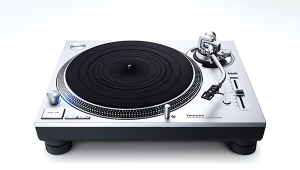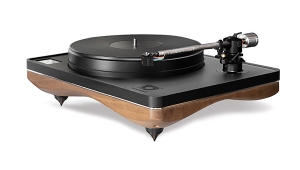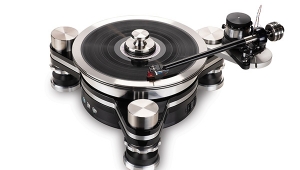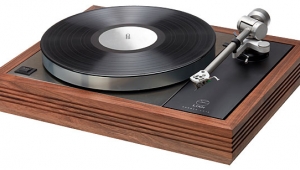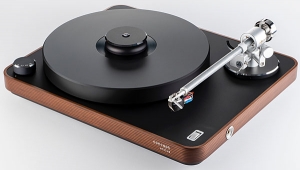| Columns Retired Columns & Blogs |
Rega P3-24, RB301, & Elys 2 turntable, tonearm, & phono cartridge Page 2
Because the P3-24 is neither isolated nor mass-loaded, what you set it on may have a noticeable effect on the sound. My review sample was placed atop a Finite Elemente Pagode stand, whose solid maple shelves sit on damped points in rigid maple frames fitted with resonance-distributing tuning forks.
Footnote 1: I hear you: full symphony orchestra or solo piano. In the words of Peter McGrath, at a recent event we attended at Audio Vision South in Tampa, Florida: "For piano, vinyl sucks!"
It takes but a few minutes to set up a P3-24 or any Rega, especially one prefitted with a cartridge. But with no leveling facilities, you'll have to make sure that whatever you place it on is itself level. Rega continues to use an O-ring interface between the RB301 tonearm's stainless-steel counterweight and shaft. I'm not sure why they use such an interface, which is more a high-frequency spring (perhaps in the audioband) than a scheme to decouple low frequencies that might lower the amplitude of the arm/cartridge's resonant frequency.
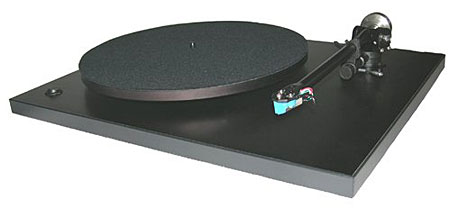
Rega eschews the Baerwald and Lofgren tonearm geometries in favor of one that produces the least distortion from an LP's innermost grooves, instead of spreading it out between the null points along the arc the stylus traverses across the record surface. But any of these overhang schemes is a compromise.
However, if you want to use a WallyTractor or other setup device using the Baerwald or Lofgren geometry, you'll need to remove the third headshell screw when using a Rega cartridge. On the other hand, if you're new to all of this, adding a Rega cartridge couldn't be easier—with three headshell screws, the mounting position is preordained: you can't make a mistake. Also note that while the RB301 arm doesn't let you adjust the vertical tracking angle (VTA), if your chosen cartridge raises the front of the arm relative to the pivot point, you can obtain shims of various thicknesses from Rega to insert between the plinth and the arm's three mounting points, to re-level the armtube to the platter.
The P3-24 ran almost precisely at both 331/3rpm and 45rpm—which, of course, is a turntable's Job No.1. I connected a digital voltmeter capable of measuring frequency to the amplifier's output and played a 1kHz test tone recorded at 331/3rpm. The result was 1007Hz, ±1Hz—an insignificant deviation.
Sound
Fitted with the Elys 2 cartridge and plugged into a variety of good MM phono preamps, the P3-24 immediately explained why the current crop of new, young vinyl devotees are so immediately captivated. The P3-24 produced big, solid images on a soundstage of exuberant size. The tonal balance tended toward the rich, warm side. Considering that kids weaned on MP3s are used to thin, smeary, constricted sound, hearing the musical riches delivered by the P3-24—or by any decent budget rig—must be akin to seeing HDTV for the first time.
But even a grizzled veteran analog-lover used to premium-priced turntables can easily appreciate the P3-24's musicality and easy flow. Only by going back to the more expensive spread can you really hear the P3-24's additive but exceedingly well-balanced sonic signature, which held steady through a variety of cartridges.
Switching to a twice-the-price Rega Exact 2 MM cartridge more than doubled the sound quality by tightening up and extending the bottom end and adding an enticing, more forward balance to the top—without changing the basic sweetness, warmth and generosity of the P3-24's sound.
Following the Consumer Electronics Show last January, I visited the home of Wilson Audio Specialties' Dave Wilson, to hear the newest edition of his Alexandria loudspeaker. A German journalist, among others on the trip, put forth an interesting (though unproven and perhaps implausible) theory that sought to explain why LPs, despite their more limited dynamic range, usually sound more dynamic than CDs, which can have measurably wider dynamic range.
As best I understood the writer's reasonably fluent English, when a lacquer is cut, the cutter head exhibits a controlled and consistent "overshoot" of its intended path, thus making the resulting inscribed waveform "bigger" than the original signal, and in turn increasing its dynamic range. Wilson Audio's Peter McGrath, who is a world-renowned recording engineer, wasn't necessarily convinced, but, like me, found the theory interesting.
Applying the theory to playback, the Rega P3-24, regardless of the familiar cartridges I used with it, seemed to expand dynamic range compared to some more expensive 'tables, while somewhat enlarging the overall physical size of the recording venue and injecting a bit of low/midbass frequency "exuberance" into the tonal balance.
The P3-24's bottom was reasonably fast, not out of control or noticeably excessive—nor was it bumped up at any particular frequency. The result was rich, tuneful, meaty bass (sorry if this sounds like spaghetti sauce), the kind that will probably go well with small, bass-shy, stand-mounted, two-way speakers. But the sound through my full-range Wilson Audio MAXX 2s was enticing as well, pop and jazz faring far better than classical.
I played a vinyl reissue of the Hindemith Violin Concerto—its world premiere recording, set down on 35mm tape by soloist Joseph Fuchs, with Eugene Goossens and the London Symphony (LP, Everest/Classic SDBR3040). While Fuchs's violin sounded rich yet agile, behind it the orchestra receded into a somewhat indistinct, almost blob-like apparition. That was with the Elys 2.
The Exact 2's presentation was much better. If you listen to a lot of classical music, are considering getting into analog on a budget, and can add a few hundred to your total outlay, I recommend the Exact 2 over the Elys 2. That's what's great about analog: spend a few hundred (or a few thousand) more and you can improve the end result considerably.
I haven't heard the seedee of Shelby "You can't roll a joint on an iPod" Lynne's Just a Little Lovin'. But the 180gm vinyl, cut from a 24-bit/88.2kHz file (LP, Lost Highway 80009789-01), sounded sweet and inviting on my big Continuum Audio Labs rig, and still enticing on the P3-24, if shorn of inner detail and nuances of touch and texture especially with the Exact 2 in place of the Elys 2. (But some non-fill noise mars side 1 of every United Nashville pressing I've heard. If'n you can't press 180gm LPs correctly, don't bother, is my advice.) On this great recording, produced by Phil Ramone and engineered by the equally great Al Schmitt on 2" analog tape, the P3-24 rolled out the liquid welcome mat, delivering Lynne's three-dimensional voice with relaxing transparency and timbral believability, cushioned by a touch of reverb. You'd need to do an A/B with a far more expensive rig to offer up any serious criticism of the P3-24's rendering of this record. Switching over to the Continuum combo fitted with the Lyra Titan i cartridge into Nagra's VPS phono preamp...well, don't ask, and I won't tell. I doubt that the CD edition, played back on any digital rig, can provide the enveloping chills offered by even an inexpensive vinyl setup such as the Rega P3-24.
While the RB301 isn't the equal of Rega's more expensive tonearms, it's literally cast from the same mold. So while its bearing tolerances may not be quite as low as the other models', the one-piece arm's rigidity is—meaning that even the P3-24's tonearm can accommodate (if not optimally) just about any cartridge you can throw at it, with great results.
But what about recordings available on both CD and LP? How would an LP played on the $1470 Rega rig compare with its CD version played on a $7000 system comprising the Musical Fidelity kW DM 25 transport and DAC? (Actually, when I ran these comparisons, the Exact 2 was in the RB301 arm—so unless Rega offers the $95 break on the Exact 2 combo, make that a $1900 Rega rig.)
I chose Charlie Haden's superb The Private Collection (3 LPs, Naim LP110; 2 CDs, Naim CD108), mastered from original analog tapes recorded live in 1987–88 by Ken Christianson at "At My Place," in Santa Monica, California (where I think I once did stand-up comedy, believe it or not). The CDs sounded satisfyingly spacious and natural. The quartet on disc 1 is laid out thusly: Ernie Watts, on sax, centered deep on the stage, with drummer Billy Higgins to his left, pianist Alan Broadbent to his right, and Haden's bass mixed tastefully center stage and not too prominent (as easily could have been the case, given that this was his recording and his 50th birthday party).
What could be more difficult for an inexpensive turntable to get right than well-recorded live sax, piano, bass, and drums? (footnote 1) With the exception of Haden's bass, which lacked ultimate control and was slightly on the droney side, everything else about the LP was better: the drum kit sounded more real and more physically there, with better cymbal shimmer, snappier snare "pop," "skin"-ier skins, and woodier rim shots; the piano was harmonically better fleshed out and more solidly present; and the sax had a more visceral, more reedy quality. Compare the drum solo (particularly the tom-toms) near the end of side 1's cover of Charlie Parker's "Passport." It's not even close.
Even the handclaps in the applause sounded more fleshy, and of course, the room's warm acoustic was far more enveloping and palpable. Again, I hear you: It's Haden's birthday party, and if he's sounding a bit rubbery and out of control, he'd probably go for the CD (unless he'd knocked down a few too many and was rubbery and out of control—but I kid him). Nonetheless, the P3-24 won the overall presentation by a considerable margin—even as the stylus approached the innermost grooves, where the high frequencies are inevitably somewhat rolled-off and softened.
If you're thinking of taking the analog plunge, you could drop a grand and a half (add more if you need a phono preamp) on a P3-24 and Elys 2, check out some of the thousands of incredible new vinyl titles currently available (not to mention the used market), and, if you're like every other reader who's contacted me after making this investment, you won't regret it. Your only regret will be that you didn't do it sooner.
Conclusion
With its thinner, more rigid plinth, more elegantly affixed and outfitted tonearm, and optional outboard power supply, Rega's new P3-24 represents an evolutionary step forward, physically, sonically, and ergonomically, in the meaty center cut of Rega's turntable line. And its TT PSU outboard power supply lets you switch from 331/3 to 45rpm at the push of a button instead of having to remove the platter and change pulley steps.
If you're obsessed more with VTA than with rigidity, the P3-24 might not be for you—but, like Roy Gandy, as long as the VTA is in the ballpark, I'll take rigidity any day (stop snickering). The ideal VTA will differ with the record thickness and the cutter head anyway, so if your goal is to play tunes, not obsess about VTA, don't worry about it. Using shims available from Rega, you should easily be able to achieve ballpark VTA with most cartridges.
Felt mats are major dust collectors and not my favorite interface, so consider something thin, not hairy, and not soft and rubbery—or use the dustcover, and wipe the P3-24's felt mat often with a dust-collecting microfiber cloth. Clean the stylus after every play, place the turntable on a level surface not directly in front of your speakers, and if you find that footfalls make the record skip and/or produce loud bangs through the speakers, use a wall mount.
If you buy a P3-24 and do all of these things, you'll enjoy its well-balanced musicality, its inviting warmth, its snappy rhythm'n'pace, and its relaxing musical flow. You'll also enjoy its elegant appearance and deceptive simplicity and ease of use in a world gone mad with complexity and "nested" features.
Oh, and when you read in the instructions that wet-cleaning your records is neither advisable nor necessary because the stylus will push the dirt out of the way, don't listen. Roy Gandy is crazy!
Footnote 1: I hear you: full symphony orchestra or solo piano. In the words of Peter McGrath, at a recent event we attended at Audio Vision South in Tampa, Florida: "For piano, vinyl sucks!"
- Log in or register to post comments
